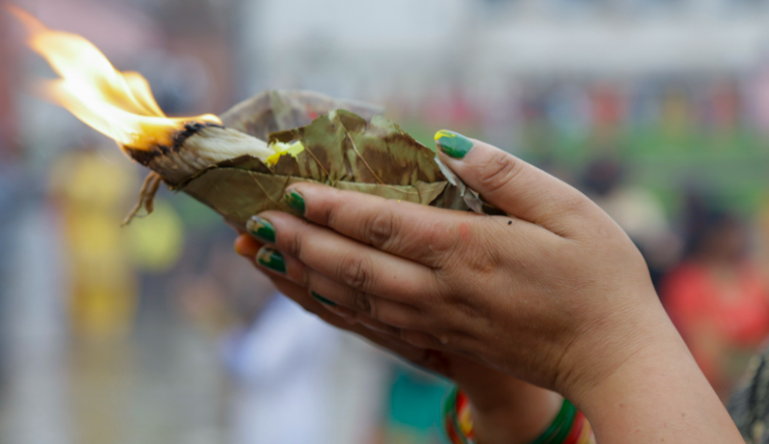Shravan, also called Sawan, is supposed to be the holiest month of the Hindu calendar. It is full of festivals and minor celebrations. Festivals include Janmashtami, Raksha Bandhan, Naag Panchami, Onam, and Kajori Purnima.
In the scriptures, Shravan is called Masottam mas, meaning the best month. The first day of Shravan, i.e., Sankranti, is given particular importance because from this day, the sun sets in the Dakshinayana (दक्षिणायन), and the days start getting shorter and the nights longer which continues till Maghe Sankranti. From the day of Sankranti, Sun leaves Gemini and enters Cancer.
According to astrology, the yoga of Shravan Nakshatra is formed in the sky on the full moon day of the month of Shravan. Hence the name of this month is Shravan.

There is an eternal tradition of considering the month of Shravan as a holy month. In the month of Shravan, people can be happy and refreshed by chanting ‘Om Namah Shivaya’ and doing meditation on Lord Shiva. Monday of this month has special significance as it is the favorite day of Lord Shiva. Be it in food or clothing, the month of Shravan brings out different flavors and colors. It is believed that during this month, fasting, worship, charity, etc., and eating sattvic food will merit.
List of Festivals in Shravan Month in 2024
| Name of Festival | Date | Details |
| Shravan Somwar Vrats (Shravan Monday Fasting) | July 22 and 29 August 5 and 12 | Falls on every Monday of Shravan month |
| Harishyani Ekadashi or Tulsi (Basil seeds) Planting Day | 17 July, 2024 | |
| Kamika Ekadashi | 31 July, 2024 | Kamika Ekadashi falls on the Krishna Paksha of Shravan month. |
| Som Pradosh Vrat | 18 July, 2024 and 1 August, 2024 | Trayodashi is called Pradosh. Observed on both Trayodashi Tithis, i.e. Shukla Paksha Trayodashi and Krishna Paksha Trayodashi, in lunar month. |
| Varaha Jayanti | 7 August, 2024 | Varaha Jayanti is the birth anniversary of Lord Vishnu as third incarnation during Satya Yuga as a bore (varaha) |
| Nag Panchami Vrat | 9 August, 2024 | Celebrated on the day of Shravan Shukla Panchami. |
| Kalki Jayanti | 10 August, 2024 | Upcoming birth date of Kalki, tenth/last incarnation of Lord Vishnu. |
| Putrada Ekadashi | 16 August, 2024 | Falls on 11th lunar day (ekadashi) of the fortnight of the waxing moon in the Hindu month in Shravan month. |
Food to eat or not to eat in Shravan Month
According to the scriptures, those who believe in Sanatan Dharma should eat pure sattvic food only once a day during these four months. Followers of the Sanatan religion do not eat Tamasi food (fish, meat, garlic, onion, etc.) and alcohol throughout the month of Shravan.
From a health point of view, it is said that our digestive system is weak this month. Therefore meat and spicy foods are not easily digested. There is also a fear of infection in such foods. That is why it is customary to eat sattvic food, and light digestible food at this time benefits the health. Fasting relieves the digestive system.
Festivals and Vrat in Shravan Month
Women do special worship to Lord Shiva, especially on Monday. According to the Sanatan Hindu tradition, it is believed that during the five Mondays of the month of Shravan, fasting by wearing green and red clothes and worshiping Lord Shiva will promote learning, business, and farming.
Also, it is believed that by fasting on Monday, unmarried ladies will get a good and handsome husband, and married ones will get long life and happiness from their husbands as well as what their heart desires.
The color of Shravan
It is also the season of greenery everywhere, colorful flowers, and a seven-colored rainbow. Women dress up in a colorful fashion to match this seven-colored landscape of nature. A combination of green, red, and yellow colors is used in summer fashion. Be it saree, kurta, or chura (bangles), these three colors are combined.
Such a color worn in summer is meaningful. Green is considered to be a symbol of love and environment, red is a symbol of good luck, and yellow is a symbol of purity.
Wearing chura, pote, and Mehendi also has social significance. Natural mehndi applied on hands also has medicinal properties. Not only does it make the hands look attractive, but it is also said to heal injuries.
Bol Bom Yatra
In Shravan, you can see a crowd of people wearing saffron (the color of renunciation) and chanting ‘Bol Bam.’ It starts on the first Monday of Shravan. Lately, there has also been a wave of Bol Bam among the youth.
The real meaning of Bol Bam is chanting the mantra of Shiva. It is said that reciting Shiva’s mantra in this way is also beneficial. When we chant the mantra, the waves it creates energize the body.
Bol Bam leads towards a sattvic lifestyle. Bol Bam walkers should completely abandon the tamasic lifestyle. From diet and lifestyle to clothing, there should be caution. It is customary in Bol Bam to eat simple and digestible food. Walking backward is called Kawariya.
The bamboo basket they carry on their shoulders is called Kanwar, and a ghaila is hung on its two sides and filled with water. It is taken to the nearest temple, and the water is offered to the Shivling. Along with that, worship is done with velpatra, kush flower, shami leaf, neelkamal, and dhatura flower.
The symbolic meaning of Bol Bam is to show the importance of water and creation. Animal life is dependent on water, and creation is not possible in the absence of water. Shivalinga is also considered a symbol of creation. If anything, it is a symbolic message that dry places should be irrigated with water from a place with a continuous water source.
It is also explained in connection with sex. At this time, libido increases in people. It is also believed that water is offered to the Shivling as a sign that it should be controlled. This saying is also associated with chura and mehendi, which women wear on their hands in Shravan. It is said that wearing bracelets throughout the month of Shravan controls the increased libido in men and husbands.
However, the religious statement is a little different. According to religious tradition, Lord Shiva’s throat turned blue due to poisoning. Lord Shiva protected the creation by absorbing the poison called Kalkut, which was released during the churning of the ocean, in his throat.
Gods and Goddesses offered him water to soothe the burning sensation of the poison he had absorbed in his throat.
Historic Incidence in Sharvana Month
According to Hindu Scriptures, two main incidents have taken place in the month of Shravan
- First, Shiva drank the Halahal vish (poison) during this month, and Indra, the god of rain and thunder, offered continuous rain to calm down the effects of halahal. Religiously, this is the reason for the tremendous rainfall in Shravan.
- Secondly, Sati did self-immolation in the Yajna organized by Daksha in Shravan month. It is believed that worshiping Shiva in Shravan month is 108 times more powerful than worshipping during normal days.
